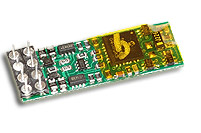
CVs are decoder memory locations that hold loco address, operational configuration and performance settings. Adjusting them to customize the performance of a specific locomotive is one of the main advantages of DCC over DC running. - Doug Stuard
These are special storage locations or "pigeonholes" in your mobile decoders. By programming various CVs, you can control each decoder's performance characteristics. CVs store information like the decoder's short address, long address, start voltage, mid-point voltage, loadable speed tables and many more. Once you have programmed these characteristics, the decoders "remember" them until you change them again. Most manufacturers use a similar set of CVs to maintain interoperability. It is a good idea to check your decoder manual to be certain that you are programming the CV designated by the decoder manufacturer to control the characteristic you are working with. Note that over time, the use of some CVs has changed.
How do I access CVs?
Each locomotive decoder has CVs which are stored in that decoder. You can change them with the DCS50 Zephyr, which is a combination throttle and command station. Or, you can change them with the DT400 connected to either the DCS100 Super Chief or the DB150 Super Empire Builder. The Zephyr and Super Chiefs allow you to "read back" the values of the mobile decoder, while the DB150 does not.
There are also computer programs such as JMRI - Decoder Pro or Juergen Freiwald's Train Programmer which give you a graphic interface view of the CV's for a decoder.